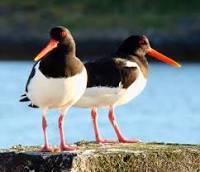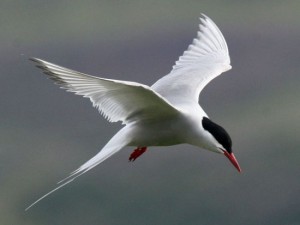John gave us a stimulating talk on this important group of birds which can be seen around our cliffs, estuaries,, mudflats and sea shores. Some such as Storm-petrels, Shearwaters and Gannets spend much of their lives at sea , visiting land just to breed, often in huge, noisy colonies. Others particularly the Gulls are more tied to the coasts but being very adaptable have also ventured inland.

Bempton Cliffs in North Yorkshire has one of the most important and best known sea bird colonies. In the spring, the cliffs are packed with thousands of Guillemots, Razorbills, Kittiwakes, Puffins, Fulmars and Shags. In summer the colony is seething with activity and noise as the adult birds come and go feeding their chicks. Nesting spots are at a premium and the stronger of the species ensure their nests are on ledges on vertical cliffs so their fledglings can propel themselves off into the sea below. Others, less fortunate may fall to the rocks below and are fair game for the many predators , particularly rats and Herring Gulls, that patrol these colonies looking for the weak and injured.

Sea birds live long lives, typically Oyster Catchers 45 years, Gulls 20/30 years, Waders 40 years Puffins and Gannets 30 years. Nature compensates by ensuring they have few surviving young. Typically Gannets have only 2 surviving young over 30 breeding seasons. In contrast blue tits live for only one or two years, but have large broods but with few survivors. Nature has its way in keeping the balance. Over the years Fulmars have increased in numbers whereas Puffins and others have decreased to levels which are causing alarm. There are many reasons for the decline. These include, sea warming, pollution, discarded fishing nets and a shortage of staple foods such as sand eels, a particular favourite of Puffins. Denmark has not helped the cause by trawling sand eels on an industrial scale grinding them down for fuel and animal feeds full of vitamins.
Gulls are a common sight at our sea sides and inland, typically on ploughed fields and refuse tips. Gulls are survivors. They are strong fliers, swim and walk with equal ease and most important can easily adapt and are resourceful. Of all the sea birds the Gulls have managed to live along side human beings, often to the annoyance of the latter The Gull family includes the Herring Gull a large, vicious, noisy and predatory bird , Greater and Lesser Black Backed Gulls and Black Headed Gulls all very common around our coasts.

No blog on sea birds would be complete without mention of Arctic and Common Terns and their considerable feats to follow the sun. Common Terns winter along the coasts of Africa whilst the Arctic Tern flies all the way from the far north to the far south to winter in the Southern ocean enjoying more summer than any other bird.
A most interesting talk with questions flowing thick and fast from the members.
